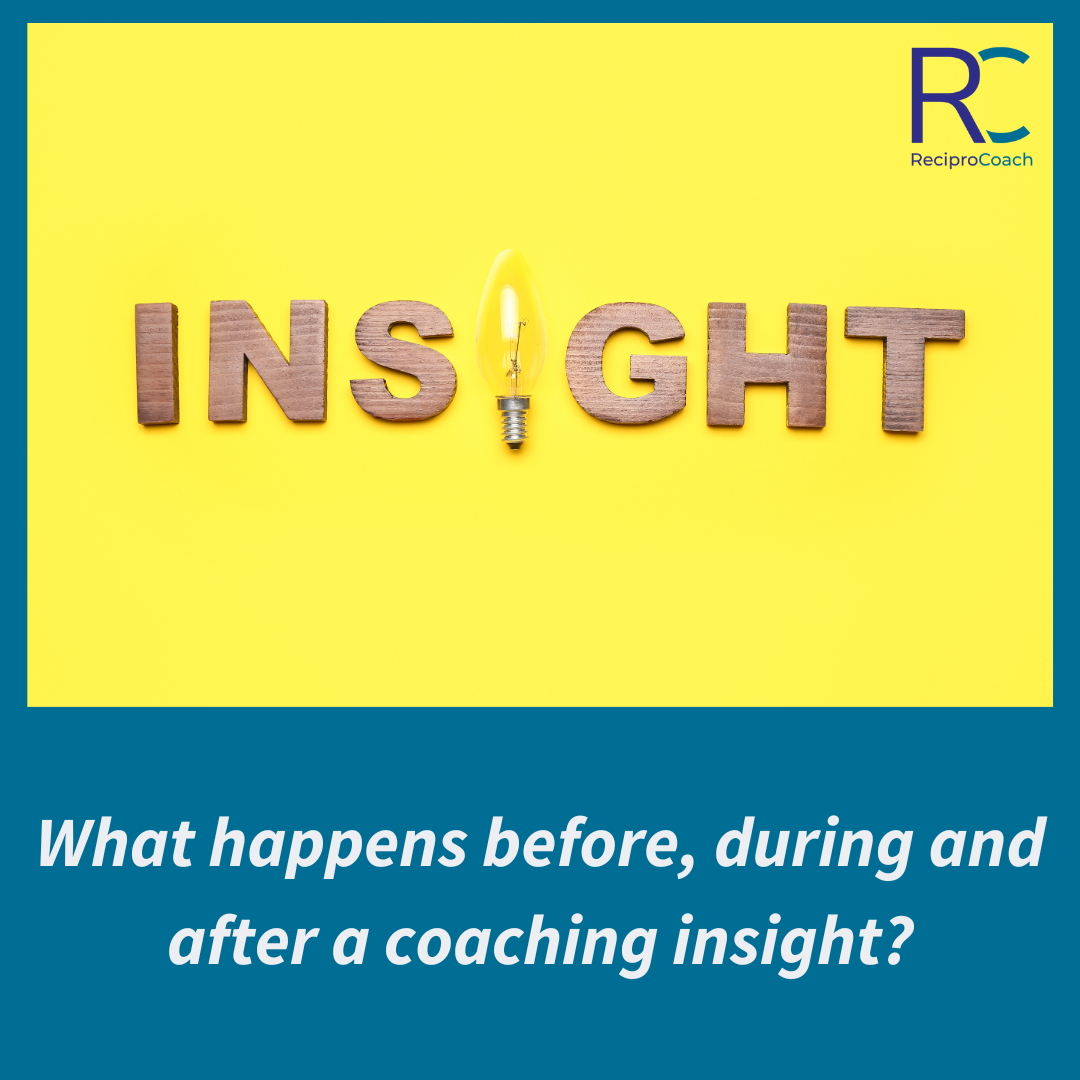What happens before, during and after a coaching insight?
This article is a reprint of a Coaching Research in Practice (October, 2019). All ReciproCoaches receive complimentary limited-time access to each new issue (10 per year). For unlimited access to more than 10 years of Coaching Research in Practice archives, purchase a membership or a subscription.
This issue of Coaching Research in Practice reviews some recent research into insight events in coaching sessions. It sheds light on a structure for insight emergence, as well as on the before, during and after events and the interplay between coach and client during the insight process.
COACHING RESEARCH
In his 2019 paper, “Insight events in coaching sessions,” Iain Lightfoot describes insights as “a time when a client appears to gain an understanding of what it is they are seeking” (p. 94). It occurs as “a moment of transformation … movement of knowledge from unknown to known … from the sub-conscious to consciousness” (p. 95), with a “combined physical and cognitive reaction” (p. 96). Lightfoot also points out that “coaches also appear to gain a significant amount of personal and professional satisfaction when these moments occur in a session” (p. 94).
Through six coach-client dyads and semi-structured interviews conducted as soon as possible after coaching sessions, analysed together with session recordings, Lightfoot’s research identified “what was happening before, during and after the moment of insight” (p. 96). The examined insight events were 100% correlated between coaches and clients as the most significant moment in the coaching session. These were examined through three lens: the coaches’ experience, the clients’ experience and the coaching session as a whole.
Lightfoot provided a summary of the before, during and after insight event from each perspective, which is too interesting not to include here in full (pp. 97-98):
Coaches’ ExperienceThe coaches were engaged in the flow of coaching when their own insight was provided to the client. This gave the client additional information to consider. Having given their clients space to think, the coaches became aware of an important moment of learning for their clients for whom the coaches’ comments resonated. This learning in their clients overall had a possible effect on the coaches who felt relieved and satisfied that they had again achieved a result. Although sometimes this familiar moment can be uncomfortable, it can bring new ideas about the direction of the next session, their own coaching skills and realisations that coaching is about continuous reflection for themselves as well as their clients.
Clients’ Experience
The clients faced pressure to solve a personal issue, an answer to which had hitherto proved elusive. The dyad was engaged in a focused exploration around their question. The clients suddenly realised that they had the answers inside themselves and that it was their responsibility to solve their issues. At this moment, a number of factors came together and the clients felt a deep sense of relief, with the realisation and insight into how they would solve their problem. Increasingly becoming more positive, there was a strong desire to continue to reflect upon this new clarity to understand the direction they could now follow. The clients were left feeling motivated and empowered with a changed mind-set. The clients left their session with an increased respect for coaching.
The Coaching Session
The coaching sessions lasted between an hour and an hour and a half, with the moment of insight occurring between 20 and 25 minutes into the session. This insight event lasted for around 4 minutes. Prior to the moment of insight, a pause of between two and five seconds. The moment occurred and it was followed by a similar pause of equal duration.

Finally, Lightfoot outlined the following insight structure (p. 99):
- Coach provides a summary
- Client verbally reflects
- A pause occurs
- Client insight manifests
- A second pause occurs
- Coach insight manifests
IN PRACTICE
The most surprising part of this research is that the insight event is catalysed by the coach providing a summary, not by the coach asking a question. This suggests that if you would like to amplify insight in your coaching sessions, you would do well to hone your summarising, bottom-lining and reflective listening skills, as well as your ability to communicate concisely.
In addition, pauses precede and follow insight, which notably are frequently accompanied by a physiological feeling. Thus, this suggests that practising the art of allowing silence helps to generate insight during your coaching sessions. Furthermore, skilled inquiry into physiological sensations may help deepen your clients’ insight experience.
Finally, this research, which first highlights client insight followed by coach insight, reinforces the importance of the coach’s state of ‘not knowing’ in the process of coaching for insight. Indeed, if the coach knows first, the entire structure of the insight event may be undermined or never occur. As a coach, it is therefore essential that you do what it takes to remain in a state of ‘not knowing’ through remaining curious and open to discover with open-ended questioning.
Reference:
Lightfoot, I. (2019). Insight events in coaching sessions. International Journal of Evidence Based Coaching and Mentoring, S13, 94-101. doi:10.24384/952t-7w52
Translating coaching research into coaching practice,
Kerryn Griffiths, PhD (The Process of Learning in Coaching)
ReciproCoach Founder and Global Coordinator
Not yet a member?
Already a member?







